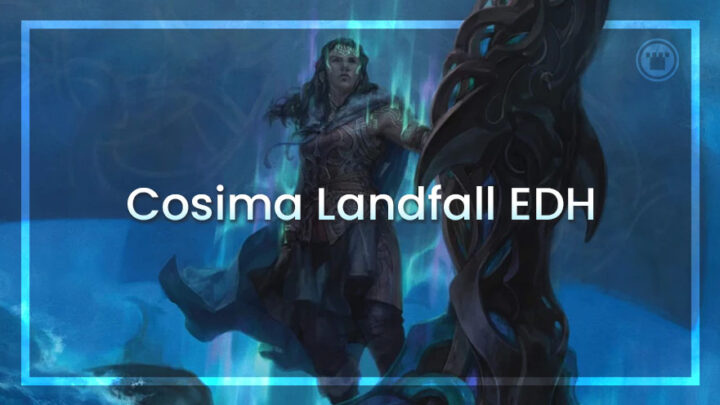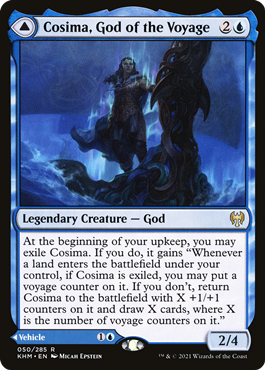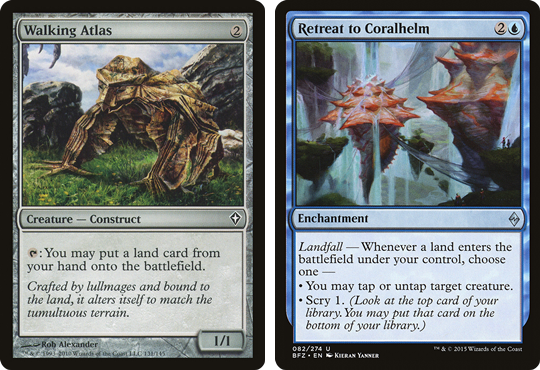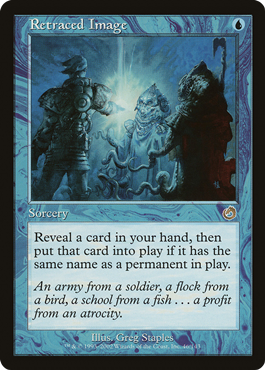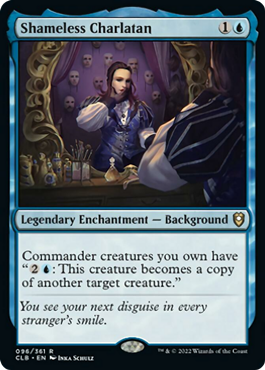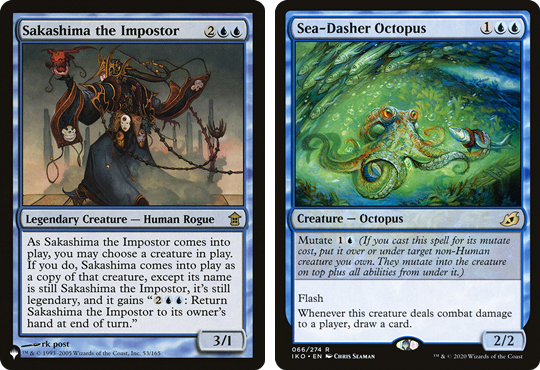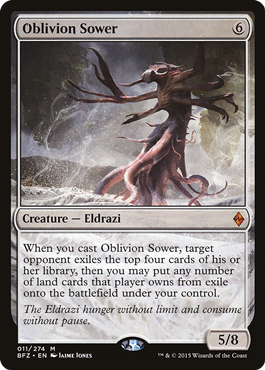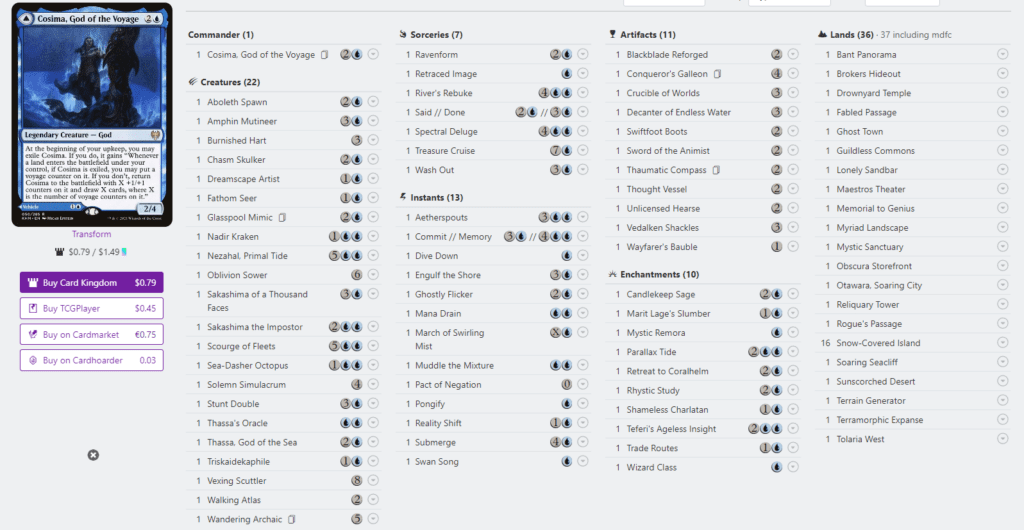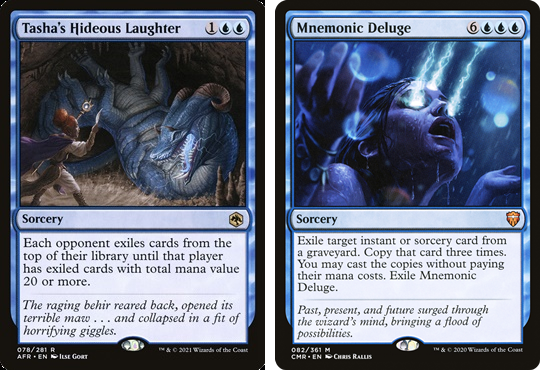Kristen takes us on a voyage with her Cosima Landfall EDH deck. She highlights how it’s fun to put aside straightforward decks to jump through hoops from time to time.
Hey folks! Last week I covered five great Commanders to try Battle for Baldur’s Gate’s new Background enchantments with, and one of the options I mentioned was Cosima, God of the Voyage. There’s been a lot of interest in seeing this list, so I thought I’d share it today.
Now, I rarely enjoy playing Blue decks, so finding one I can enjoy was pretty monumental. There’s something else special about this deck, though, and that’s its deliberate intention to jump through hoops.
We all enjoy playing straightforward, powerful decks. That’s one of the reasons I picked up Miirym, the Sentinel Wyrm and wrote a deck primer on it. That style of deck is punchy, potent and wins in a blunt manner. Yet, it’s also fun to work a little harder for the win.
Jumping through hoops is the art of playing a slightly more inconsistent build that has to put a lot of effort into pulling off its game plan. What you give up in consistency, you gain in novelty and replayability.
Cosima is that deck for me, so here’s the low down.
Cosima, God of the Voyage
Cosima, God of the Voyage has one strong ability, and it’s one of the most satisfying crossovers of function and flavor I’ve ever seen (if you remember Bounty of the Luxa from Amonkhet block draft, you’ll get this straight away). Essentially, Cosima leaves on a voyage, and her time spent away essentially shapes her experience. Seeing new “lands” grants her wisdom in the form of card draw. It’s elegant and I love it.
The thing is, she’s Blue. Landfall is always best in Green, the color of putting extra lands into play, so trying to make this work in mono blue is an uphill struggle. That, personally, is what drew me to the deck.
Working for a win is super satisfying, and doubly so when you could manage it much more easily in other colors. It’s also immensely satisfying to have other players enjoy your slightly off-the-wall deckbuilding.
If you look at EDHREC, most Cosima decks go down the vehicle route pretty heavily to synergize with The Omenkeel, the other mode of Cosima. Me? I barely ever cast it, because I’m much too busy enjoying drawing cards. If you’re looking for a vehicles deck, this is not the deck list for you. Keep reading though, because you might enjoy it anyway.
Win Conditions
Cosima wins games of EDH with combos, but remember — we’re not doing things the easy way in this deck. Two card combos? Bah, way too easy. We’re going for four card combos here. They’re a little janky, in the best possible way.
They all start with two key ingredients — the salt and pepper, if you like — of the deck: Walking Atlas and Retreat to Coralhelm. Putting a land into play with Walking Atlas will trigger Retreat to Coralhelm, allowing us to untap Walking Atlas. This is the basis for infinite loops of land, but we’ll need a couple more pieces to truly let us end the game.
The first option is Guildless Commons. This land’s trigger makes you bounce a land back to hand when it enters play — so we simply bounce the Commons itself and keep putting it into play until we’re done.
But how do we use the landfall triggers? Well, first we need to have Cosima in exile, ready to get voyage counters. Then we perform the loop X times, where X is enough to trigger Thassa’s Oracle’s win condition. Usually it’s safe to just draw ourselves out here, but beware of effects that can mess with that math. Bring Cosima back with one final landfall trigger, draw your library and then play Thassa’s Oracle with all your counterspells in hand.
Our other win condition here involves Trade Routes, one of the best cards in the deck. We use Walking Atlas to put Sunscorched Desert into play, then tap it for a colorless mana. Activate Trade Routes to return the desert to hand, then replay it with the Atlas ad infinitum.
I like to imagine this combo as Cosima boring everyone to sleep with tales about her voyage… “But let me tell you about the desert!” And if anyone wants to argue that a desert isn’t exactly sea-themed, well, you just have to remind them a desert is half a beach. Trade Routes can, of course, be used for value plays too – like bouncing Mystic Sanctuary for completely fair and reasonable purposes.
Muddle the Mixture is also a key counterspell for us, as it lets us search out Trade Routes, Thassa’s Oracle and Walking Atlas. It also gets us another win condition: Blackblade Reforged. Cosima can get pretty big, after all. That’s not to mention the removal it gets us in Reality Shift, a semi-fog in Thaumatic Compass and Marit Lage’s Slumber – another win condition.
Oh and we play Triskadekaphile… another win condition! Two really is the magic number for this deck. Meanwhile, Tolaria West lets us find our combo lands in a pinch (I do love transmute).
Mono Blue Landfall?
Of course, to get to the win condition, we also need to have a consistent way to draw cards and find interaction or combo pieces. Thankfully, Cosima does most of the heavy lifting — but we’ll need to try our damndest to make landfall work in mono blue to truly pull this off.
In the mana base alone, we have a bunch of fetch lands, plus utility ways to get more land drops in Ghost Town, Terrain Generator and Drownyard Temple. We use what we can in blue for extra land drops: Wayfarer’s Bauble, Dreamscape Artist, Burnished Hart, Solemn Simulacrum… the usual suspects. There are, however, a couple of spicy inclusions.
Retraced Image allows us to essentially pay {U} for an extra land drop. Most commonly, this will allow us to drop an Island into play, but occasionally, you can play your Solemn Simulacrum for one mana if there’s already one across the table, which is pretty neat.
The card that always steals the show for me is Parallax Tide. By playing this and exiling five of your lands with Cosima in exile, you can get those lands back again in your upkeep when it checks for Fading. This gives you five triggers on Cosima for four mana, which is a really good rate. If you’re playing landfall creatures like Roil Elemental, it can steal a player’s whole board. Then, when you’re trying to win during the late game, it can also mess with an opponent’s lands – cutting them off of colors or their Maze of Ith for a turn. It’s super fun and a reason to play the deck.
Enabling Cosima
The way Cosima ebbs and flows, you don’t get to send her away as often as you’d like. When you do send her away, it can be tempting to let her sail as long as possible. The tension is in when to bring her back, as you will need to draw cards to keep up with the other players at the table.
Besides Rhystic Study and Mystic Remora, we have Candlekeep Sage and Teferi’s Ageless Insight, which both act as ways to “reduce” the time Cosima is in exile — effectively turning her card draw up a notch and letting you send her away more often.
As I mentioned last week, the new Shameless Charlatan lets us convert Cosima’s +1/+1 counters into evasive or value-based damage by turning her into a copy of an opposing evasive creature, or one with double strike. It’s a fun way to get utility out of our Commander who otherwise exists to draw cards and eventually beat face.
Two other mechanics interact favorably with Cosima: Clones and Mutate. The former can come in as copies of Cosima, and, if they’re around on your upkeep, can be sent away using her trigger. Because the card itself gains the rules while in exile, it will amass counters and can be brought back much like Cosima. Get this, though – it can then enter as whatever creature you want to copy while still getting the +1/+1 counters. Because most clones don’t target, this is a great way to get a large, dangerous creature and draw a bunch of cards.
Mutate is similar; if you’ve mutated Cosima, the Mutate creatures go into exile and are stamped with Cosima’s rule, too. Both are great ways to draw even more cards, and you can certainly go hard on both mechanics if you want to. I preferred to not play “Oops, all clones!” for this build, but it’s certainly doable.
Speaking of sea creatures, I run a whole bunch. They make good blockers and then threaten/control the board when they get larger. Nezahal, Primal Tide and Scourge of the Fleets really help close out a game.
The star of the deck has to be Oblivion Sower, though. If we can get set up in the right way – perhaps exiling lands with the Omenkeel or Unlicensed Hearse, or playing against a greedy Delve or impulse draw player, we can instigate a tidal shift in the amount of lands we control. Oblivion Sower is both a way to ramp to absurd levels and to draw lots of cards with Cosima. It’s a great card, and one I wish I could play more than one copy of.
Cosima Landfall deck list
The full deck list comes in at $373 and, of that amount, a good chunk is concentrated on Mana Drain, Rhystic Study, Crucible of Worlds and Snow-covered Islands. If you dropped those and chose to play regular islands, you could put this together pretty cheap indeed.
Hell, you could even do what I do, and have a “Declaration of Snow” emblem in the deck box. I don’t enjoy the art of the Snow-covered Islands, so I use Rule 0 to explain that I’d like my basics to be Snow before the game starts. I’ve never had anyone object.
You’ll notice I included Reliquary Tower, Thought Vessel, Decanter of Endless Water and Wizard Class, and it’s for good reason — this deck can draw a lot of cards and we don’t like to discard them if we can help it.
I’ve stuck to a sea theme for many of the card choices, and while this does let me play powerful cards like Aboleth Spawn and Stunt Double (it has a guy in a tricorn!), it does limit the power of the deck — something I’m personally more than okay with.
Vexing Scuttler, a card you probably forgot from Eldritch Moon, is massively on theme for the deck… but it is strictly worse than Archaeomancer in many ways, save for the ability to pop our Chasm Skulker on demand. It’s these sorts of inclusions you’d be looking at refining if you wanted to push the deck to its limits, especially given Ghostly Flicker plus Archaeomancer allows for some chain-landfall action.
The overall strategy is to enjoy Cosima’s ebb and flow, control the board, stay alive long enough to draw the combos and try to pop off, all while protecting your plan with counterspells. It’s hoop jumpy in the best way and it’s one of my favorite decks.
Further Refinements

Choosing exactly 100 cards for an EDH deck will always be difficult. These are some of the swaps I’ve made recently in order to test new cards (you’ll notice I dropped some sea-themed cards for others that might do more work).
It was hard to let Desertion go, but five mana is a lot. Likewise, I really loved the flavor of cards like Vortex Elemental and Dulcet Sirens, but their power level was unfortunately a little low for the tables I wanted to play Cosima at.
As the deck is capable of making a lot of mana, it’s perfectly reasonable to include Eldrazi Titans to really lean into the eldritch/sea theme and have a payoff for such large amounts of mana. I don’t own any, so it’s not something I’ve considered.
Given I love Oblivion Sower so much, I have considered adding Tasha’s Hideous Laughter in as an alternate win condition. To really make the most of it, you’d need Mnemonic Deluge for sure — but the potential Oblivion Sower possibilities gained by playing this sorcery are tantalizing. Even if this doesn’t end up milling everyone out with the Deluge, you can be sure that your opponents will have scant left to work with.
One combo I’ve deliberately avoided, from a purely taste perspective, is infinite turns. It’s easy to accomplish this in a Cosima deck, given Trade Routes allows us to bounce Mystic Sanctuary and keep putting Time Warp back on top of our library. If you want to do it, be my guest – but it’s one of those combos that’s a little too easy. After all, the whole goal of today’s article is to show that it’s much more fun to jump through hoops than it is to play easy combos.
Finally, I could also be playing Meloku, the Clouded Mirror and Patron of the Moon — and perhaps even Intruder Alarm, in order to generate oodles of value and a bunch of tokens. My omission of them in this list is primarily to keep my decks feeling distinct; I have a Tameshi, Reality Architect brew that really wants to be behind on land drops that can use these thematic Kamigawa cards just as happily.
End step
Cosima Landfall is an EDH deck that’s always enjoyable to play, and that’s precisely because it takes a little effort for things to pop off. Having a four piece combo and needing to keep your Commander coming and back and forth from exile is, in essence, a mini-game within the game — and that leaves a lot of room for extra fun.
The deck does, however, require a table that is still playing past turn 7-8. All decks that want to jump through hoops need to get to turn 8-10 to really be in their element, and I’d encourage you to try building a deck that’s a little more complex in game plan if you’re struggling to come up with something to play at slightly slower tables.

Kristen is Card Kingdom’s Head Writer and a member of the Commander Format Panel. Formerly a competitive Pokémon TCG grinder, she has been playing Magic since Shadows Over Innistrad, which in her opinion, was a great set to start with. When she’s not taking names with Equipment and Aggro strategies in Commander, she loves to play any form of Limited.

